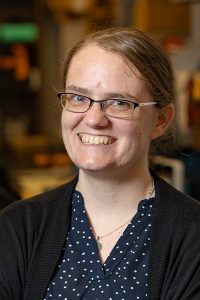 The computing revolution has, if anything, only continued to speed up in recent years, with ever-faster, ever-more powerful machines performing operations that could have only been dreamt about even within the decade before.
The computing revolution has, if anything, only continued to speed up in recent years, with ever-faster, ever-more powerful machines performing operations that could have only been dreamt about even within the decade before.
Keeping up with the challenge requires cutting-edge research into complex algorithms, data, and software libraries; the development of new materials that make up components of the machines themselves; and reducing the amount of energy required to run them and keep them cool enough to operate.
That’s where Catherine Schuman comes into play.
Schuman, an assistant professor in the Min H. Kao Department of Electrical Engineering and Computer Science (EECS), has an array of knowledge in those areas, particularly in relation to neuromorphic computing, which uses the way the neural network that makes the brain work as an inspiration in developing new means of computing.
Her expertise led to her recently joining an ongoing effort led by University of California, San Diego, Distinguished Professor Ivan Schuller called Quantum Materials for Energy Efficient Neuromorphic Computing, or Q-MEEN-C for short.
“I was brought in because of my understanding of materials used in neuromorphic systems with the goal of developing new pathways that could further improve this type of computing and make it far more efficient,” said Schuman. “The goal is to establish a full suite of applications and algorithms that we use in neuromorphic computing and use those in co-design to gain an understanding of what works best with each material, device, or circuit.”
To further explain that last part, Schuman had the perfect analogy.
“It’s like gaining the ability to have a toolbox full of tools so that you can pick the right one for the task at hand,” Schuman said. “For example, there are a lot of tools you could use to try to bang a nail into a board, but having a hammer makes it many times easier.”
Q-MEEN-C’s overall objective is to bring about the development of neuromorphic computing that is fault-tolerant and based on quantum materials. It was selected for the US Department of Energy (DoE) funding through as part of the Energy Frontier Research Centers program.
One of the many things that the DoE oversees are the vast supercomputing machines, like Frontier at Oak Ridge National Laboratory, currently the world’s fastest. One of the costs of operating such building-sized devices is the vast amount of resources spent both powering them and cooling them, something Q-MEEN-C could also positively impact.
“This project gives us the opportunity to create devices that operate at radically reduced power levels,” Schuman said. “With neuromorphic computing, we’re developing an entirely new approach for computing across the entire compute stack, starting at the materials and devices all the way up to algorithms and applications. It will be hard, but it’s exciting.”
The team just completed its first four years and picked up a renewal to expand its goals, which is what led to Schuman joining the team. There are now more than 20 co-PIs on the project from around the world.
For her part, Schuman is gaining $500,000 in funding over four years, and will be able to have a student, current EECS senior Lexi Velas, join her moving forward.